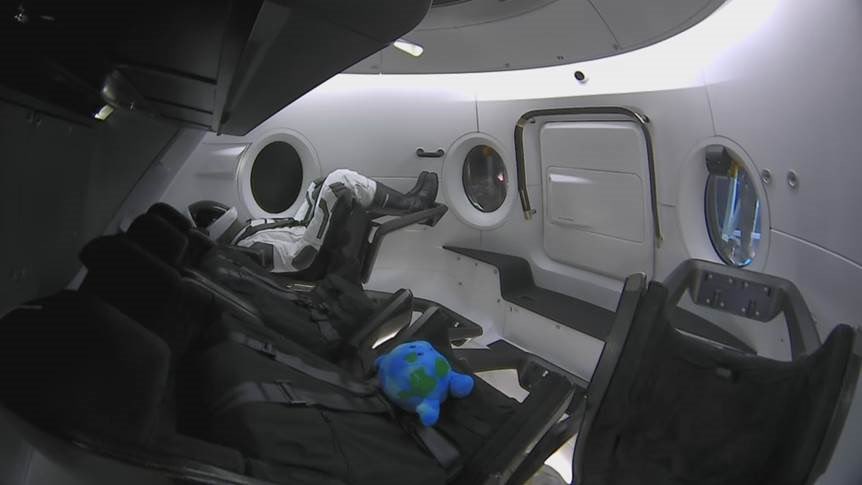
CAPE CANAVERAL, Fla. — Elon Musk sees a bright and busy future for SpaceX's newly debuted Crew Dragon capsule.
Crew Dragon launched to orbit for the first time ever this morning (March 2), kicking off an uncrewed, six-day demonstration mission to the International Space Station (ISS) known as Demo-1. If all goes well with this flight and an upcoming emergency-escape test, Crew Dragon could fly two NASA astronauts to the orbiting lab this summer.
Operational missions, which would carry four people per trip, would begin sometime thereafter.
Related: SpaceX Dragon Crew Demo-1 Test Flight: Full Coverage
The vehicle's near-term future involves ferrying NASA spaceflyers, and astronauts from ISS partner nations, to and from the station. SpaceX has been developing Crew Dragon under a $2.6 billion commercial-crew contract with NASA, after all. But over the longer haul, Musk said, he'd like to open Crew Dragon to space tourists as well.
"People have gone to space station on Soyuz," he said this morning during a post-launch press conference here at NASA's Kennedy Space Center, referring to the handful of private citizens who have flown aboard Russia's Soyuz spacecraft (and reportedly plunked down between $20 million and $40 million apiece to do so).
"And I think it'd be pretty cool if people went to space station on an American vehicle as well," Musk added. "I think that's something that we'll do, and NASA's very supportive of that."
Get the Space.com Newsletter
Breaking space news, the latest updates on rocket launches, skywatching events and more!
Looking even farther out, "maybe there's something beyond space station," he said. "We'll see."
Musk's grand plan, of course, involves settling other worlds such as Mars. That's the main reason he founded SpaceX in 2002, the billionaire entrepreneur has said repeatedly over the years — to help humanity become a multiplanet species.
Crew Dragon, which can hold a maximum of seven people, isn't built for such ambitious exploration work. So, SpaceX is developing a new spaceflight system, which consists of a 100-passenger spacecraft called Starship and a huge rocket dubbed Super Heavy, both of which will be reusable.
SpaceX has already built a small-scale "hopper" prototype of Starship, which Musk has said might begin making brief test flights within Earth's atmosphere in the coming weeks. If all goes according to plan, Starship and Super Heavy will launch a Japanese billionaire and numerous other passengers on a round-the-moon mission in 2023, and perhaps send the first people toward Mars a few years later.
Musk envisions Starship and Super Heavy eventually carrying all of SpaceX's load, doing everything from launching satellites and crewed Red Planet missions to cleaning up space junk and ferrying people on "point-to-point" trips around Earth.
So get an eyeful of Crew Dragon, its cargo-carrying cousin and SpaceX's Falcon 9 and Falcon Heavy rockets while you can — their days are probably numbered.
- Meet Ripley, SpaceX's Dummy Astronaut Riding on Crew Dragon Test Flight
- SpaceX's Crew Dragon Demo-1 Test Flight in Pictures
- Take a Walk Through SpaceX's Crew Dragon Spaceship
Mike Wall's book about the search for alien life, "Out There" (Grand Central Publishing, 2018; illustrated by Karl Tate) is out now. Follow him on Twitter @michaeldwall. Follow us on Twitter @Spacedotcom or Facebook.
Join our Space Forums to keep talking space on the latest missions, night sky and more! And if you have a news tip, correction or comment, let us know at: community@space.com.

Michael Wall is a Senior Space Writer with Space.com and joined the team in 2010. He primarily covers exoplanets, spaceflight and military space, but has been known to dabble in the space art beat. His book about the search for alien life, "Out There," was published on Nov. 13, 2018. Before becoming a science writer, Michael worked as a herpetologist and wildlife biologist. He has a Ph.D. in evolutionary biology from the University of Sydney, Australia, a bachelor's degree from the University of Arizona, and a graduate certificate in science writing from the University of California, Santa Cruz. To find out what his latest project is, you can follow Michael on Twitter.









